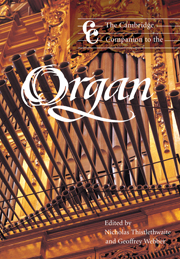Book contents
- Frontmatter
- Part I The instrument
- Part II The player
- Part III Selected repertoires
- 10 Italian organ music to Frescobaldi
- 11 Iberian organ music before 1700
- 12 The French classical organ school
- 13 English organ music to c1700
- 14 Catholic Germany and Austria 1648–c1800
- 15 The north German organ school
- 16 The organ music of J. S. Bach
- 17 German organ music after 1800
- 18 French and Belgian organ music after 1800
- 19 British organ music after 1800
- 20 North American organ music after 1800
- Appendix: The modes (toni) and their attributes according to Zarlino
- Notes
- Bibliography
- Index
12 - The French classical organ school
from Part III - Selected repertoires
Published online by Cambridge University Press: 28 September 2011
- Frontmatter
- Part I The instrument
- Part II The player
- Part III Selected repertoires
- 10 Italian organ music to Frescobaldi
- 11 Iberian organ music before 1700
- 12 The French classical organ school
- 13 English organ music to c1700
- 14 Catholic Germany and Austria 1648–c1800
- 15 The north German organ school
- 16 The organ music of J. S. Bach
- 17 German organ music after 1800
- 18 French and Belgian organ music after 1800
- 19 British organ music after 1800
- 20 North American organ music after 1800
- Appendix: The modes (toni) and their attributes according to Zarlino
- Notes
- Bibliography
- Index
Summary
A survey of French organ music before 1800 is bound to recognise the unique flowering of the years 1660 to 1740. The repertory of this period is often referred to as ‘classical’, the term ‘baroque’ ill suiting, according to some commentators, the essential nature of its musical language. The corpus of extant music is large and includes music by well-known and versatile composers such as Guillaume-Gabriel Nivers (1632–1714), François Couperin (1668–1733) and Louis-Nicolas Clérambault (1676–1749). Others, such as Jacques Boyvin (1653–1706), André Raison (d. 1719) and Pierre Dumage (1674–1751), are known only for their organ music. The work of these composers merits pride of place in an account of French organ music of the seventeenth and eighteenth centuries.
The publications of the last forty years of the seventeenth century stand out as the central monument in the classical school (see Table 12.1). They emanate from the period in French history when Louis XIV outstripped all his European rivals in cultural endeavour. The beginning of his reign, from 1660, marks the coming of age of French baroque music. The Italian artists and musicians, imported by Cardinal Mazarin (1602–61) to boost the claims of Italian culture over French, left in the early 1660s, bereft of their patron. The more or less final manifestation of their struggle was the performance in Paris in 1662 of Cavalli's Ercole amante, an event noted for the success of the additional dance music by the young Jean-Baptiste Lully rather than Cavalli's score. The moment was ripe for a resurgence of national identity and pride in French art.
- Type
- Chapter
- Information
- The Cambridge Companion to the Organ , pp. 176 - 189Publisher: Cambridge University PressPrint publication year: 1999
- 1
- Cited by



